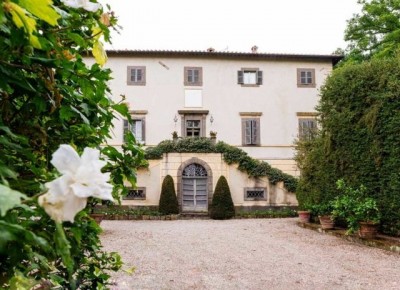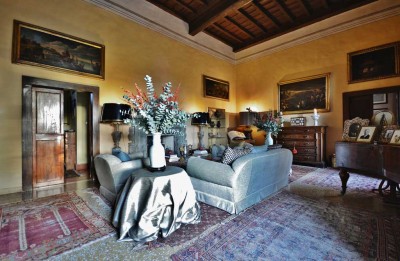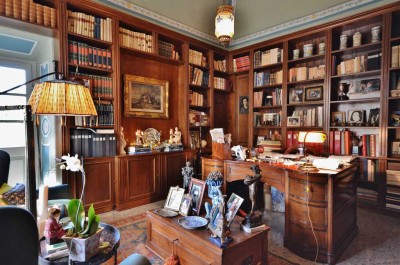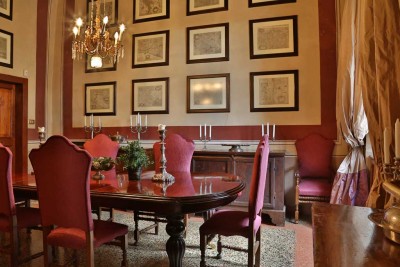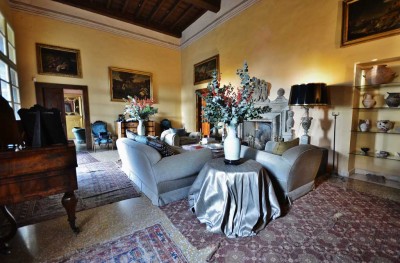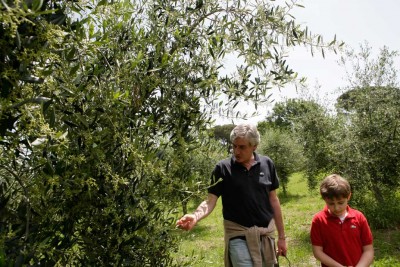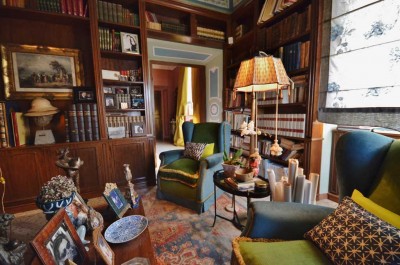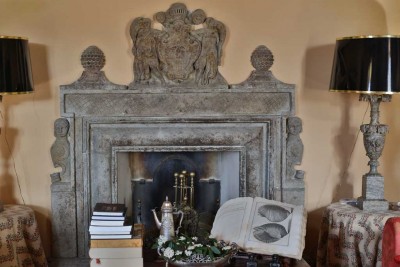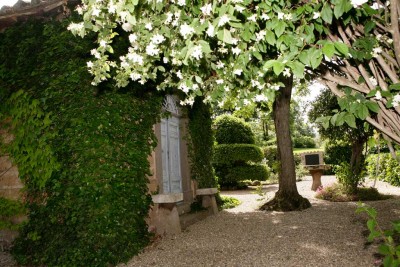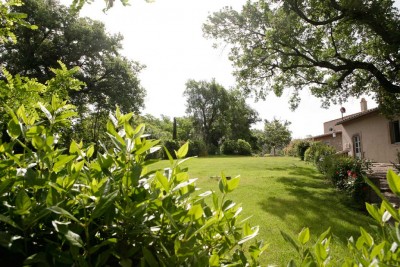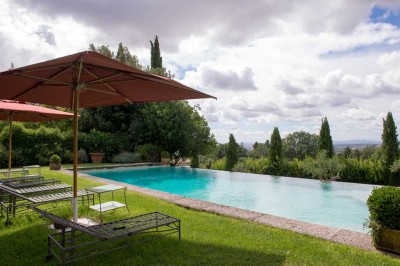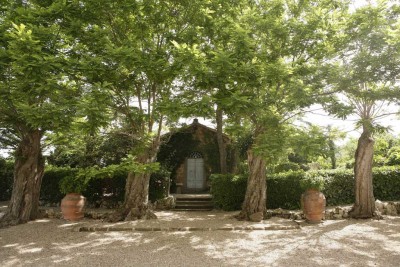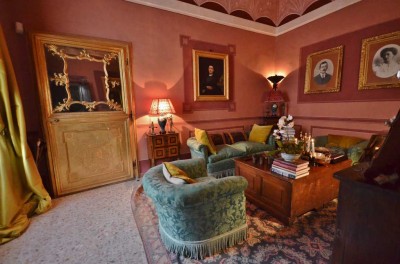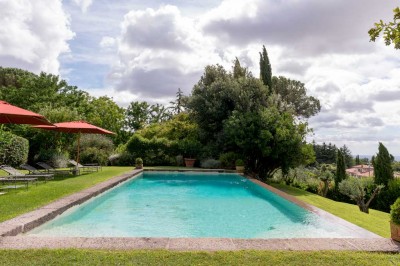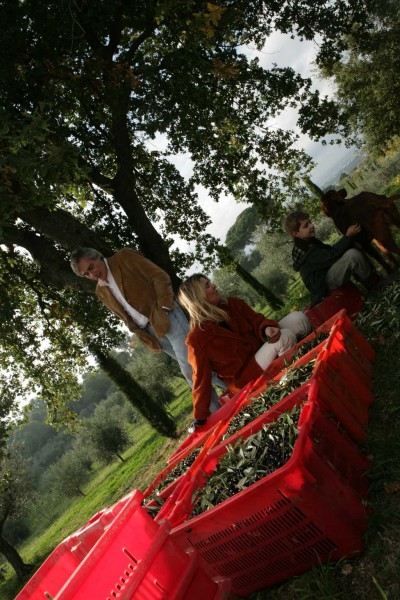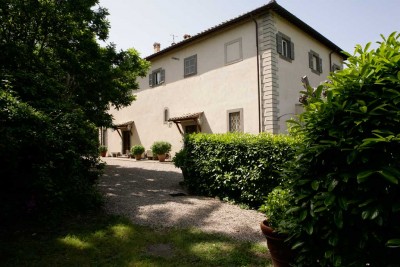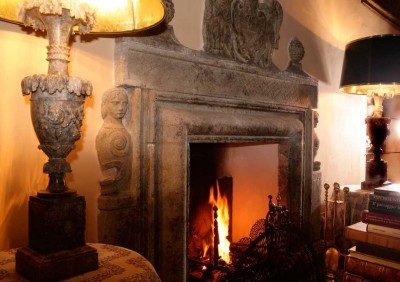Contact the abode
The monumental estate of Villa Rossi Danielli consists of two neighbouring structures that are from different periods and differing styles: the Villa, which has been the summer residence of the Rossi Danielli family since the beginning of the 19th century, and the old farmhouse building, formerly inhabited by the local farmers who used to tend the land, which has now been completely restored and converted into guest quarters. Access to the property is through a narrow gate supported by two peperino (volcanic tuff) stone pillars, which are in fact the superposition of the exterior upper curves of the repeated mullioned windows of a destroyed portico from the convent of S. Maria in Gradi that were replaced during restoration work carried out to enlarge the convent in 1738. The two pilasters are composed of 18 elements each; at the top is an additional 'upright' element surmounted by a ball, also made of peperino. A counter-pillar stands adjacent to the columns, similarly in peperino blocks, bearing the faded image of a small column.
A long avenue bordered by cypress and olive trees leads to the entrance to the estate. The Villa is a compact building with a rectangular floor plan spread over five floors, including the cellars underneath the building and extending up to the attic area. The main façade, facing south and west, consists of a three-storey structure that expands into a wider platform for the two terraces that widen the base at the level of the ‘piano nobile’ main floor. This is the result of exploiting the natural slope of the terrain, which made it possible for the ground floor to house service rooms on one side and entrance halls used as storerooms on the other, while creating two majestic, monumental twin staircases leading to the main entrance of the Villa on the first floor, at the top of which the principal entrance door to the Villa is found.
An epigraph is carved across the lintel, namely: A.R.P.M. F.J.DETERAN. SOCIUS HISPANIAE. F. ANN MDCCXCVII, which in full would read as: ADMODUM REVERENDUS PATER MAGISTER FRATER JOACHIM DE TERAN SOCIUS HISPANIAE FECIT ANNO MDCCXCVII. Translated from the Latin, the inscription states: "Most Reverend Father Master Brother Joachim de Teran, Companion of Spain, made this in the year 1797".
Above the door, a large sundial softens the austere façade of the main body of the Villa, which has recently been restored, fully respecting its historical appearance and the typical architecture of the time. The period decorations and the refined and original furnishings of the noble floor lend an overall aura of elegance and sophistication. A large hall with a fireplace, a library, a billiard room, and several other living rooms complete this ‘piano nobile’, clearly intended to facilitate leisure pursuits. On the ground floor, a long gallery houses the dining room, while a spacious kitchen equipped with a long staircase carved into the tuff stone leads directly down to the cellar, where wines of great value are stored. A small service bathroom completes this residential part of the Villa. On the left side at ground level and adjacent to the staircase leading to the main entrance, are rooms which have been directly carved into the peperino rock, used until recent years as storage spaces, stables and tool sheds. One of these rooms features unusual architectural decorations with mouldings and niches still clearly visible on its walls, one larger than the others and located in the centre of two openings that lead into two more small rooms facing the entrance. Due to its size and prominent position on the wall, this niche most likely originally housed a large statue, which is unfortunately now lost.
All these elements, combined with the proximity of a water cistern used until recent times, were in all probability part of a nymphaeum, a place that in every Renaissance villa was used to provide relief from the summer heat, and was usually adorned with statues, water features and sometimes wall ornaments made with shells and river pebbles. Formerly called simply a "grotta" or cave, because very often the decoration had the appearance of an underground grotto, the nymphaeum was always a place of seclusion place compared with the busy daily life of the villa, as can also be witnessed at the nearby Villa Lante in Bagnaia and many other villas in the Viterbo area. Considering the position of this environment in relation to the present Villa, it is likely that it was part of an older structure that predated the construction that stands over it today.
The farmhouse attached to the Villa, the oldest part of which dates back to the same period, was enlarged in more recent times, towards the end of the 19th century, and extends over two floors. The upper floor was used as living quarters for the farm workers, while the ground floor was employed as a stable and a place of storage for agricultural tools. Today, it has been completely renovated and converted into ‘agritourism’ farmhouse accommodation, named the Relais di Villa Rossi Danielli, consisting of 5 rooms, each with an independent bathroom: 1 suite with a private sitting room and fireplace, 2 large double rooms and two rooms with single beds, one of which has a private sitting room.
On the ground floor, the old stables have been restored and transformed into a communal area. There is a large living room heated by a grand fireplace, where guests can gather with friends, as well as a dining room and a kitchen where the cook, Enrica, is always happy to prepare meals for guests. The porch is an ideal place to sip a good glass of wine or enjoy a lunch or candlelit dinner, immersing oneself in the open air and an atmosphere of times gone by.
The park consists mainly of tall trees, such as oaks, holm oaks, locust trees, pines and lindens, plus viburnum and laurel hedges, but, most notably, it features two monumental boxwood galleries that adorn the main façade of the Villa. Trees with circumferences ranging from 2.50 to 3.75 metres give the architectural estate a monumental, solemn appearance. Flourishes of roses, dahlias, lilies and above all hydrangeas contribute to make a walk in the park an unforgettable olfactory and visual experience.
The presence of the swimming pool, nestled in the park amidst an atmosphere of peaceful stillness, invites guests to completely relax and enjoy a leisurely stay.
A small country church, which lends itself perfectly to private ceremonies, completes the ensemble.
From the villa, you can enjoy a spectacular view of Viterbo and the Lazio Maremma region, with glimpses of the Argentario promontory and the sea on clear days. The expanse of olive trees surrounding the villa produces a PDO olive oil that is sold and appreciated all over the world.
THE HISTORY OF VILLA ROSSI DANIELLI
The villas in the Viterbo area almost all have a history that connects them to patrician families or convents of the various religious orders, within the context of a sharecropping type of agricultural activity. The history of Villa Rossi Danielli is no exception. In fact, the earliest confirmed record takes us back to the second half of the 16th century, when Giacomo Sacchi, an exponent of a rich and noble family that had settled in Viterbo in 1297 with Giovan Giacomo Sacchi, who had been invested with the office of Treasurer of the province of the estate, was the owner of the villa and the surrounding farm. Prior to the 16th century, we have only a few vague references regarding the management of the estate, which at that time was cultivated as a vineyard.
On 3 July, 1587, Giacomo Sacchi dictated his will, stipulating that his second wife, Lucia de Bussi, should receive a quarter of the property's income located in the Merlano area. This was in fact the toponym by which the territory west of the provincial road Viterbo-S. Martino al Cimino was and is still identified. He instructed his heirs to retain ownership of the property, stipulating that should a need to dispose of it arise, they were to give first preference to selling it to the Dominican fathers of the convent of S. Maria in Gradi or secondarily were to pass it to the city hospital. In 1586, Orazio Sacchi, son of Giacomo, married noblewoman Giulia Tignosini in the chapel of the estate. In 1650, on Orazio's death, his sons Domenico and Tarconte ceded ownership of the villa and the surrounding estate to the Dominican fathers of S. Maria in Gradi, who then used the Villa as a summer residence for distinguished guests visiting the convent. The inscription on the main gate commemorates the stay of the Most Reverend Father Master Fr. Joachim de Teran, assistant for the Spanish-speaking provinces of the Dominican Order's Master General Fr. Balthasar de Quinones, in the villa in 1797. He was the first of many illustrious personalities to stay at the Villa and it is probable that he was also involved in the restoration of the villa, with the consent of the entire religious community.
The late 18th century marked a very uncertain period for the Papal States. Napoleon was concluding his first campaign in Italy and French soldiers entered Romagna, bringing new concepts to the Pope's territories. Ancona was occupied, and the Treaty of Tolentino confirmed the loss of the Legations of Bologna, Ferrara and Romagna, as the provinces of the ancient Papal States were called. In an atmosphere of great social innovation, a revolutionary wind blew over the Papal States and in February 1798, General Berthier's troops occupied Rome and reached Viterbo. Thus began the plundering of Italy's artistic heritage and their migration to Paris, which also affected the two most important Dominican possessions in Viterbo: the convent of S. Maria in Gradi and the convent of the Basilica of S. Maria della Quercia.
Father Semeria, a Dominican from the convent of S. Maria della Quercia, left written records that Luigi Rossi Danielli, a member of an ancient and noble family from Viterbo, acquired the convent’s monumental estate from the French government on 19 June, 1812, in order to prevent the looting of the works of art in the Basilica. Unfortunately, he was unable to save the treasures in the Basilica, but he managed to salvage the apothecary's shop, plus the paintings and other works of art in the convent. Once the French horde had passed, he returned the convent to the Dominicans, and it was during this period, at the beginning of the 19th century, that the Villa became the property of the Rossi Danielli family. In addition to the convent, Rossi Danielli also acquired the 16-hectare estate together with the manor house and annexed farm building from the Dominican fathers.
In more recent times, in the 1960s-1970s, Villa Rossi Danielli hosted His Majesty King Gustavo Adolfo VI of Sweden, also a renowned archaeologist, who came to Viterbo to personally conduct excavation campaigns organised by the Swedish Institute of Classical Studies in Rome in the Acquarossa and Ferento areas, which are also owned by the Rossi Danielli family. Another Rossi Danielli, Luigi, who is similarly an archaeologist, had previously unearthed the remains of the Roman theatre in Ferento at the beginning of the 20th century.
FACILITIES AND SERVICES: STAYING IN A HISTORICAL VILLA IN THE VITERBO COUNTRYSIDE
Arriving at Villa Rossi Danielli signifies crossing the threshold into a different world, a world governed by friendliness that is rich in history, shows great attention to detail and has a magical atmosphere.
Villa Rossi Danielli is the ideal location for travellers wishing to visit Tuscia and the Villas of Viterbo, as well as exploring the Lazio countryside. Situated just a few kilometres from the centre of Viterbo, those staying at the Villa will enjoy a travel experience from another era. Guests will benefit from sleeping in comfortable rooms and relaxing in the extensive, verdant grounds where they can immerse themselves in total relaxation.
All visitors to the Relais of Villa Rossi Danielli will be assured of receiving a very warm welcome.
The owners will also be on hand to organise tours of Tuscia and cooking lessons.

